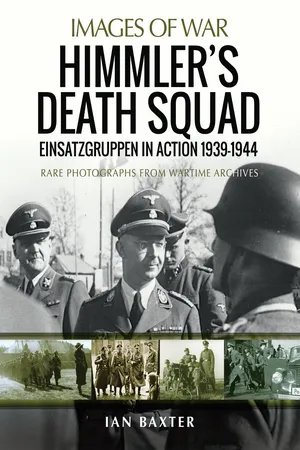![]()
Chapter One
Murder in Poland
When the German army advanced into Poland on 1 September 1939, bewildered Polish commanders struggled desperately to hold their forces together. The Polish Army’s withdrawal was not a panic flight. It was a kind of stubborn retreat. Villages and towns in the objective area were strongly held by a mixture of Polish troops and partisans, and guerrilla warfare broke out in many places. German soldiers became nervous about the progress of the ‘legendary march’, and so if shots were fired at them from a village in bandit country, they torched houses, razed villages, and the inhabitants, innocent as well as guilty, found themselves facing firing squads. Surrendered Polish soldiers in uniform were usually shot.
However, even more sinister activities were beginning to generate terror. Behind the regular German army lurked the SS Death Head groups or Totenkopfverbande under the command of Theodor Eicke. Three regiments had been deployed: SS Oberbayern, Brandenburg, and Thuringen. Eicke’s men quickly gained a reputation, torturing and killing Poles regarded as hostile to the Reich.
The German army were fully aware of the systematic campaign of slaughter in the rear areas. A few regular soldiers and commanders became uneasy, and some actually complained to their superiors, but nothing was done to stop the killing.
Now Heydrich released the Einsatzgruppen into the rear areas for the first time. In a series of meetings held in August 1939, he had explained that the mission of the Einsatzgruppen would be to kill members of the Polish leadership. This would include the intelligentsia, teachers, the clergy and nobility. As Hitler said, ‘There must be no Polish leaders. Where Polish leaders exist they must be killed, however harsh that sounds.’ Using dossiers collected by the SD, lists were drawn up of the people to be killed in Poland.
For this the Einsatzgruppen were tasked not with employing their military capabilities but instead terrorizing the civilian population through acts that included hunting down straggling Polish soldiers, confiscating livestock and agricultural produce, and torturing and murdering public figures such as Polish political leaders, business men, priests and intellectuals.
Initially the Einsatzgruppen numbered 2,700 men, and by the time they were sent to Poland that figure had risen to 4,250.
Their mission was ‘cleansing and security measures’ and their activities in Poland would give the Poles a fitting introduction to the character of German rule. The Einsatzgruppen operations received the cover name ‘Tannenberg’.
As the Einsatzgruppen roamed the countryside they searched houses, secured areas, and arrested and summarily shot anyone they deemed suspicious. The mentally ill and the disabled, including patients recuperating in hospitals, were murdered.
In Sladow, 252 PoWs were shot or drowned; at Ciepielow some 300 PoWs were killed; and at Zambrow a further 300 were murdered. Polish PoWs of Jewish origin were regularly selected and executed.
The Wehrmacht leadership did seek to discourage so-called ‘wild’ shootings, where troops would kill civilians on their own initiative. In fact there were court-martial proceedings against some junior officers who had led these shootings. But this was nullified on 4 October 1939 when Hitler pardoned all military personnel who had be...
